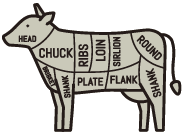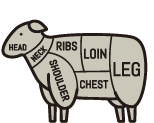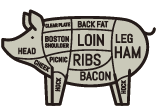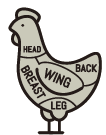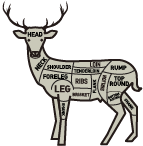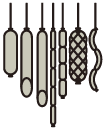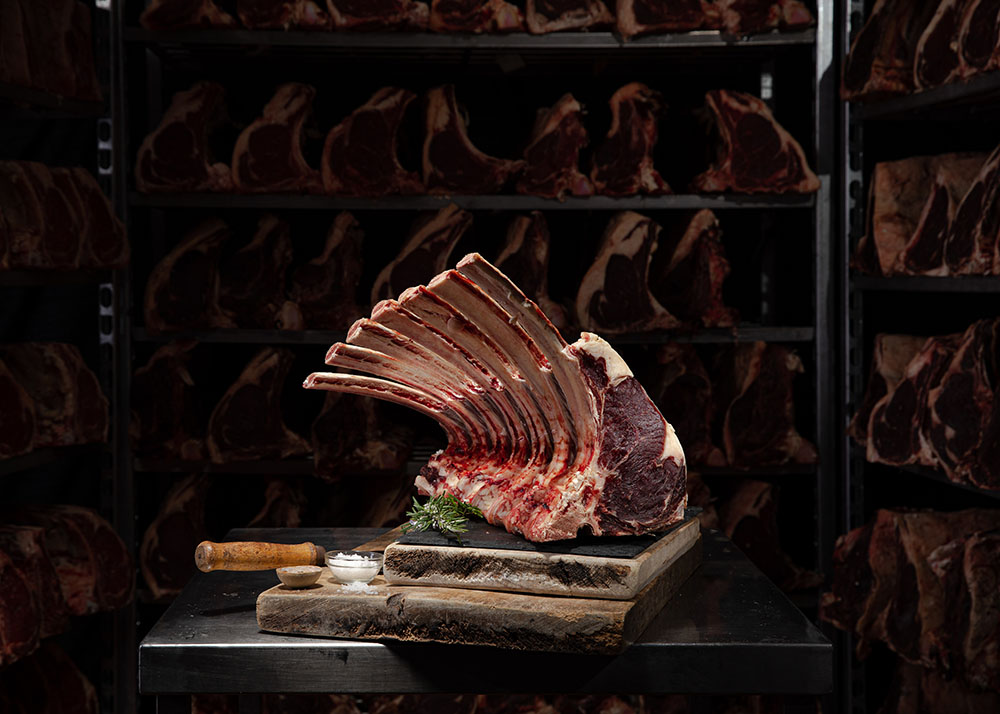
Our Beef
We source our beef from a small group of farmers in the South Leinster area. These local farmers practice excellent husbandry. They feed their livestock only the best of grass and grain and administer no artificial growth promoters, additives or preservatives.
About Our Beef
All of our Beef is processed by O’Gorman’s of Castledermot. Here the animals are handled in the quiet environment of a small farm abbatoir. They are kept in small pens and do not mix with other animals which can cause them stress. It is these small differences in the welfare of the animals which make a big difference in the quality of the meat they deliver to us.
Twice a week Niall O’Gorman and his team deliver beef fresh from the abbatoir.
Our Beef is a cross continental breed, we feel that not limiting our selection to one breed we can gaurennte better consistency thought the year.
Upon arrival at our factory Pat hand selects each carcass ensuring that the level of quality and consistency is never compromised. Each carcass is traceable directly to the farmer, location, herd no etc.
The prime cuts from our beef are held in our Cold Room for 14 to upwards of 28 days.
Know Your Cuts
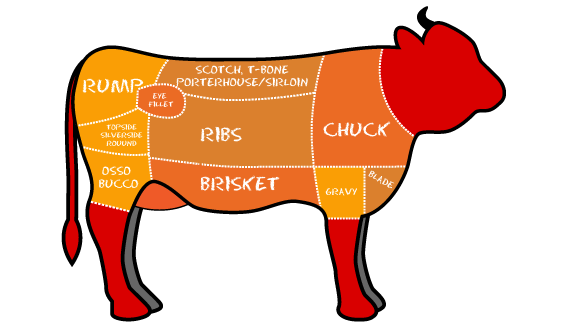
Click on each heading below to read more about each cut of meat
Sometimes called a Daube of Beef this piece of meat comes in a portion size and usually weighs about 350 -400 gr. When cooked it will be a very generous portion for one. It is best slow cooked in a casserole dish with a marinade of red wine (there are many recipes on the internet) for 6-8 hours over a low low heat. Chefs cook them in vacuum pouches in a bath of 62 degrees water. We sell them in individual vacuum pouches if you wish to cook them this way yourself.
This comes from the leg of the animal and is best for stewing. Because the leg muscle works a lot the shin is very flavoursome and its toughness will disappear with long slow cooking. As the meat breaks down in the cooking it releases its intense flavour into the liquid of the stew.
This is an inexpensive cut of beef that comes from the hindquarter (bottom!). It is interchangeable with a cut called TheRound. It is a hard working muscle so it is not as tender as the sirloin – hence it is less expensive. As a general rule the more tender a cut of meat is, the more expensive it will be. It can be bought as Steak or Roast. As a roast it is best when it is braised, which means cooked with some liquid in a closed utensil such as a casserole dish in the oven or in a covered pan on the hob. In both cases it will be cooked over a long period of time at a low temperature. As steak, the best cuts of it may be tender enough to fry or it can be tenderised by the butcher and grilled or fried. For best results one should brown it on a frying pan and then transfer it to a casserole or covered pan and cook slowly with some onions and a little gravy.
This is the meat that comes from the neck and shoulder of the animal. It is usually cut into 1 inch cubes and sold as stewing beef. Like the shin it is very flavoursome and melts in your mouth when cooked slowly for a decent length of time. The beauty of slow cooking is that it is difficult to get it wrong ! The only danger is that you don’t have sufficient liquid in the pan as it can boil off if the pan isn’t covered or the heat is too high. A perfect temperature is when the liquid is barely simmering.
The Brisket is a very large long piece of meat that is cut from each side of the breastbone. In America it is sometimes referred to as The Plate which is the big single piece of lean meat that is within the Brisket. They tend to use it for slow roasting or Pastrami. In Ireland Brisket is sold sometimes as a Pot Roast but mainly it is salted and sold as Brisket Corned Beef. There tends to be fat running through it and when boiled, the meat is fork-tender and the fat lovely and sweet- a favourite in our shop.
This is a tender cut of meat that sits on top of the hip.It is sold in shops as Sirloin Steak or Rump Steak and it is ideal for frying or grilling. It consists of a couple of different muscles and sometimes the butcher will seam it into cuts such as London Broil, which is a beautifully flavoursome cut ( also known as tri-tip) which can be roasted whole.
This is a large very lean piece of meat from beside the Topside and as the name suggests, it comes from the rear end of the animal ! In Ireland it is always salted and sold as corned beef. It is too tough to eat as steak. At Christmas time butchers will rub a special mix of spices onto the outside of it and sell it as Spiced Beef. Corned Beef is always boiled in water and is very tender and flavoursome when cooked.
A long tender muscle that sits on either side of the backbone, it is very tender and makes beautiful steaks with a nice covering of fat. Also called a New York Strip and is sometimes confusingly referred to as Sirloin. The Fillet sits under this and when they are left attached to the bone and cut as steaks you get a T-Bone Steak ( named after the shape of the bone ) a heifer that a butcher will sell in his shop will weigh about 280- 350 kg. The Fillet from this will weigh about 4 – 6kg.
This is the soft underbelly of the animal that has some large cuts of meat whose texture is very loose because of the expansion and contraction of the belly. These cuts are being used increasingly by restaurants as they seek tasty alternatives to the scarce and therefore expensive fillet. The Bavette is a large piece of meat weighing 900gr – 1500gr. The French love it and most of the Bavette produced by Irish Factories would be exported to France. When you marinate the Bavette in a little oil and lemon and fry over a high heat until just rare, it’s a delight. The Flank /Goose steak comes from this region also and is very popular for Beef Stirfry. The Skirt Steak also comes from here but is a poor cousin to the Bavette.
This cut consists of the meat between the 5th and the 12th rib of the animal (there are 13 ribs). This is where we get the Ribeye steak, hugely popular in restaurants for its flavour and tenderness. The Cube Roll is the same cut of meat except it is left in one piece for roasting. This is also where we get the Rib Roast that our grannies cooked for Sunday dinner. The Rib roast is either left with the rib bones in or they are taken out by the butcher and he ties the meat up into a roll for cooking.
This is a relatively new cut in Ireland and consists of the 1st – 5th rib, cut about 6 inches long with the thick layer of lean and flavoursome meat attached. It is also known as Short Ribs or Thick Cut Ribs. They are slowly braised until the meat falls from the bone.
This is a cut of meat that sits beside the …you guessed it… Shoulder Blade. It is relatively tender and very flavoursome. It is ideal for slow cooking in a casserole dish ( as is the Topside ).Other cuts from this area are the Oyster /feather/ flatiron steak. It has lovely marbling which gives it a great taste.
Our Meat
Premium quality
Our Services
Professional & reliable
Easy to order
Unify app
Our reach
Nationwide delivery

